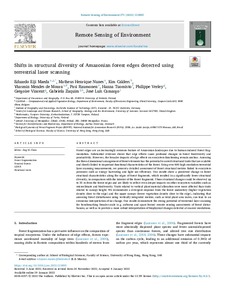Shifts in structural diversity of Amazonian forest edges detected using terrestrial laser scanning
Calders Kim; Maeda Eduardo Eiji; Verley Philippe; Tuomisto Hanna; de Moura Yhasmin Mendes; Raumonen Pasi; Zuquim Gabriela; Camargo José Luís; Vincent Gregoire; Nunes Matheus Henrique
Shifts in structural diversity of Amazonian forest edges detected using terrestrial laser scanning
Calders Kim
Maeda Eduardo Eiji
Verley Philippe
Tuomisto Hanna
de Moura Yhasmin Mendes
Raumonen Pasi
Zuquim Gabriela
Camargo José Luís
Vincent Gregoire
Nunes Matheus Henrique
ELSEVIER SCIENCE INC
Julkaisun pysyvä osoite on:
https://urn.fi/URN:NBN:fi-fe2022081155090
https://urn.fi/URN:NBN:fi-fe2022081155090
Tiivistelmä
Forest edges are an increasingly common feature of Amazonian landscapes due to human-induced forest frag-mentation. Substantial evidence shows that edge effects cause profound changes in forest biodiversity and productivity. However, the broader impacts of edge effects on ecosystem functioning remain unclear. Assessing the three-dimensional arrangement of forest elements has the potential to unveil structural traits that are scalable and closely linked to important functional characteristics of the forest. Using over 600 high-resolution terrestrial laser scanning measurements, we present a detailed assessment of forest structural metrics linked to ecosystem processes such as energy harvesting and light use efficiency. Our results show a persistent change in forest structural characteristics along the edges of forest fragments, which resulted in a significantly lower structural diversity, in comparison with the interior of the forest fragments. These structural changes could be observed up to 35 m from the forest edges and are likely to reflect even deeper impacts on other ecosystem variables such as microclimate and biodiversity. Traits related to vertical plant material allocation were more affected than traits related to canopy height. We demonstrate a divergent response from the forest understory (higher vegetation density close to the edge) and the upper canopy (lower vegetation density close to the edge), indicating that assessing forest disturbances using vertically integrated metrics, such as total plant area index, can lead to an erroneous interpretation of no change. Our results demonstrate the strong potential of terrestrial laser scanning for benchmarking broader-scale (e.g. airborne and space-borne) remote sensing assessments of forest distur-bances, as well as to provide a more robust interpretation of biophysical changes detected at coarser resolutions.
Kokoelmat
- Rinnakkaistallenteet [27094]
